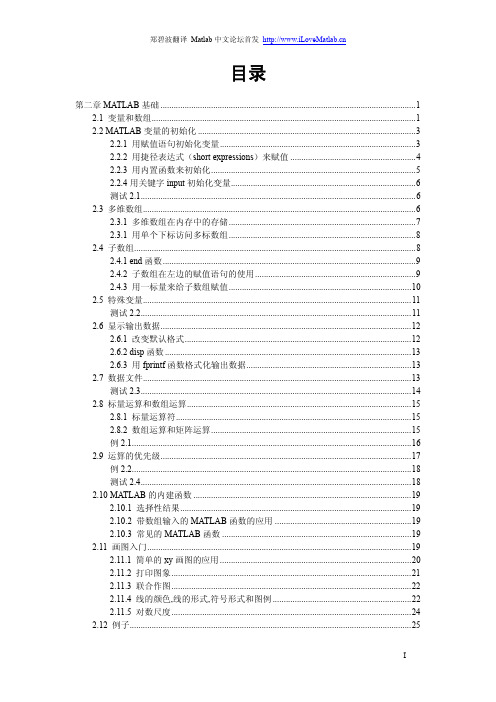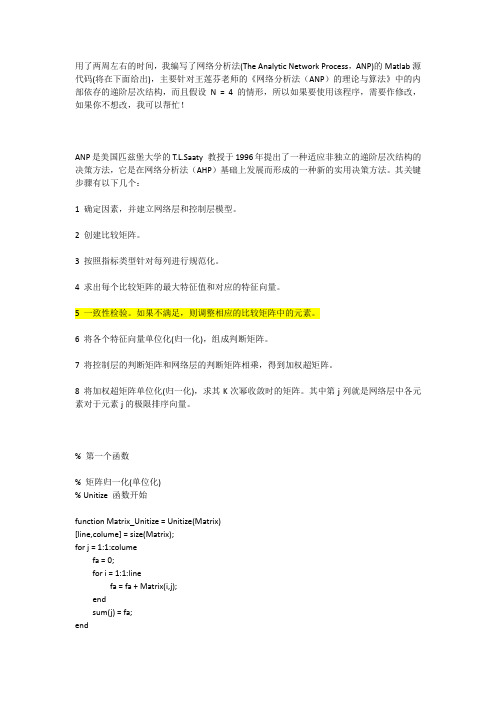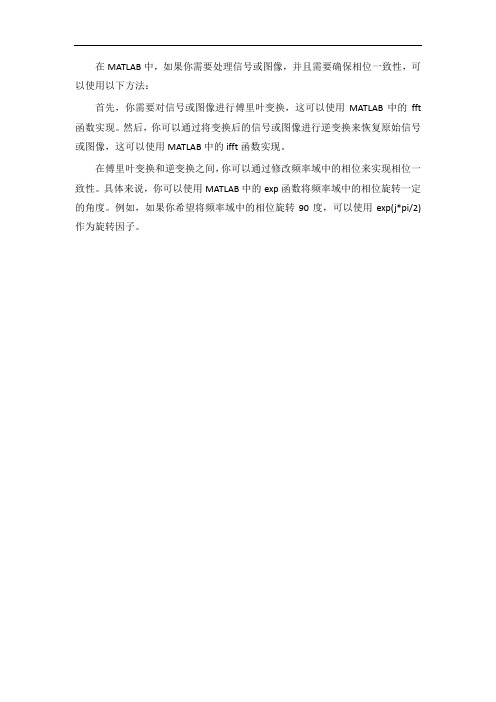相位一致性 Matlab 源代码 第二版
二相编码信号matlab代码

如果你想在Matlab中生成二相编码信号,你可以使用Matlab的逻辑函数。
以下是一个简单的示例,生成一个二相编码信号,其中逻辑高电平被表示为1,逻辑低电平被表示为0。
matlab
% 定义时间向量
t = 0:0.01:10; % 从0到10秒,每0.01秒一个点
% 定义二相编码信号
phase_shift_keying(0.5*sin(2*pi*50*t) + 0.5*sin(2*pi*120*t)); % 例子信号,此处需替换为你的实际信号
% 画图
figure;
plot(t, phase_shift_keying);
title('二相编码信号');
xlabel('时间(s)');
ylabel('幅度');
grid on;
在这个例子中,我使用了相位偏移键控(PSK) 来生成二相编码信号。
phase_shift_keying 是Matlab内置的函数,它接受一个在-1和1之间变化的相位调制信号,并返回一个二相编码信号。
在这个例子中,我生成了一个频率为50Hz和一个频率为120Hz的正弦波信号的相位调制信号,然后将这个信号输入到phase_shift_keying 函数中,得到一个二相编码信号。
你需要替换掉例子中的信号,使用你实际需要生成的二相编码信号。
matlab nsga2 源代码

matlab nsga2 源代码Matlab NSGA2源代码是一种基于多目标遗传算法的优化算法。
该算法主要用于解决多目标优化问题,通过遗传算法的方式,寻找一组最优解,这些解在多个目标函数下都能取得较好的结果。
NSGA2是NSGA的改进版本,相对于NSGA,NSGA2在选择操作上进行了改进,使其更加适用于多目标优化问题。
NSGA2算法的核心思想是通过遗传算法的方式,通过选择、交叉和变异等操作,不断进化种群,使得种群中的个体逐渐趋于最优解。
在选择操作中,NSGA2采用了非支配排序和拥挤度距离的策略,以保证种群中的个体具有多样性和均衡性。
非支配排序是指根据个体在目标函数上的性能,将其划分为不同的等级,等级越高表示该个体越优秀。
拥挤度距离是指个体在种群中的密度,距离越大表示个体越独特。
通过这两个策略,可以选择出种群中的精英个体,以保持种群的多样性。
NSGA2算法的主要步骤包括初始化种群、计算目标函数值、非支配排序、计算拥挤度距离、选择、交叉和变异等。
在初始化种群阶段,需要设定种群的大小、个体的维度和目标函数的个数。
在计算目标函数值阶段,需要根据问题的具体情况,编写相应的目标函数计算代码。
在非支配排序和计算拥挤度距离阶段,需要根据个体在目标函数上的性能进行排序,并计算个体的拥挤度距离。
在选择操作阶段,需要根据非支配排序和拥挤度距离的策略,选择出精英个体。
在交叉和变异阶段,需要通过交叉和变异操作,生成新的个体,并更新种群。
NSGA2算法的源代码可以在Matlab平台上进行实现。
在使用NSGA2算法解决具体问题时,需要根据问题的特点进行相应的参数设置和目标函数编写。
同时,为了提高算法的优化效果,还可以结合其他优化算法或启发式算法进行改进和优化。
Matlab NSGA2源代码是一种用于解决多目标优化问题的优化算法。
通过选择、交叉和变异等操作,不断进化种群,以寻找一组最优解。
NSGA2算法以非支配排序和拥挤度距离的策略,保持种群的多样性和均衡性。
matlab2psk调制与解调代码 -回复

标题:Matlab2PSK调制与解调代码详解
在通信系统中,调制和解调是两个至关重要的过程。调制是将信息信号转换为适合在特定信道中传输的信号的过程,而解调则是将接收到的信号恢复为原始信息信号的过程。在这个过程中,Phase Shift Keying (PSK)是一种常见的数字调制技术,包括二进制相移键控(BPSK)、四进制相移键控(QPSK)等。以下我们将通过Matlab代码详细解析PSK的调制与解调过程。
匹配滤波
h = rectpulse(10);匹配滤波器脉冲响应
filtered_signal = filter(h, 1, bpsk_signal_noisy);
判决门限设置
threshold = 0;
received_data = filtered_signal > threshold;
BPSK解调
在这段代码中,我们首先生成了一组随机的二进制数据,然后使用"pskmod"函数将其调制为BPSK信号。其中,函数的第二个参数"2"表示我们正在使用二进制相移键控。
接下来,我们来看一下QPSK的调制过程。QPSK是在BPSK的基础上,每个符号携带两个比特的信息。以下是一个简单的QPSK调制代码示例:
matlab
matlab
生成随机二进制数据
data = randi([0,1],1000,1);
K调制
bpsk_signal = pskmod(data, 2);
添加高斯白噪声
snr_db = 10;信噪比(dB)
noise_power = 1/(10^(snr_db/10));
bpsk_signal_noisy = awgn(bpsk_signal,snr_db);
全相位校准算法及matlab代码

全相位校准——信号相位的精确估计方法一、全相位校准算法如何准确确定信号中强线谱的相位?可用全相位校准方法(apFFT)。
apFFT测相位需要2N-1个样点,测出的2N-1个样点中间点的时刻的相位值。
原FFT测相位需要N个样点,测出的是第1个样点时刻的相位值,但它须校正.实用时,我们对一个正弦波连续取样2N-1点,测出的是第N个样点的相位,但若要知道第一个取样时刻的样点相位,即初相位,须知第N个样点的时间T,从测量值减去相隔T的相位值,即初相位.但实际上,测一个正弦波的相位,我们不知道它什么时候开始的,测时离起始时间多运.但这没有关系.apFFT测的是任一样点时刻的相位,即样点相位。
目前流行的相位计测的都是比较相位,被测信号和一个同一频率参考信号的相位差。
相位差指两个同一频率的正弦波的相位差,测出同一时刻的二个正弦波的相位,其差值就是相位差,任何时刻测出的同一频率二个正弦波的相位差都是一样的.所以同一频率的两个正弦波的相位差物理意义十分清楚。
apFFT测相位差就是分别测二个信号在任何同一时刻的相位,其差值即相位差,即同时对二个同频信号分别取2N-1点,用apFFT测出中间样点相位,其差值即相位差.流行的相位计直接测被测信号和一个同一频率参考信号的相位差,它不能测样点相位,是十分不同的.样点相位测量是十分有用的,如两个电网要并网,需要同频同相同幅,测出同一时刻的两路的样点相位是首要的.apFFT测相位需取2N-1个样点,若取样间隔有变化,apFFT仍正确测量;例1 下面是全相位FFT测初相位的程序clear;clf;tt = -4095/2000:1/2000:4095/2000;yy = cos(2*pi*100.4*tt+pi/3)+cos(2*pi*150.6*tt+pi/2);NFFT = 4096;yy1 = yy(1:NFFT*2-1);yy1 = yy1(:);%vecter = [1:NFFT,NFFT-1:-1:1];%vecter = vecter/NFFT;vecter = conv(hanning(NFFT)',hanning(NFFT)');vecter = vecter/NFFT/max(vecter);for ii = 1:NFFT-1,yy2(ii) = vecter(ii)*yy1(ii) + vecter(NFFT+ii)*yy1(NFFT+ii);endyy2(NFFT) = vecter(NFFT)*yy1(NFFT);yy2=[yy2(NFFT) yy2];yy2_fft = fft(yy2,NFFT);yy2_phase = phase(yy2_fft)*180/pi;yy2_phase = mod(yy2_phase,360);disp('初相位测量值')yy2_phase(206)yy2_phase(310)例2:4根谱线的相位精确估计clear;clc;NFFT = 128;tt = -(NFFT-1)/2000:1/2000:(NFFT-1)/2000;yy=cos(2*pi*100*tt+23*pi/180)+cos(2*pi*150*tt+33*pi/180)+cos(2*pi*300 *tt+43*pi/180)+cos(2*pi*500*tt+63*pi/180);%4根谱线频率分别为100,150,300,500,初相位分别为23,33,43,63yy1 = yy(1:NFFT*2-1);vecter = conv(hanning(NFFT)',hanning(NFFT)');vecter = vecter/NFFT/max(vecter);yy1a= yy1.*vecter;yy2=yy1a(NFFT:end)+[0 yy1a(1:NFFT-1)];yy2_fft = fft(yy2,NFFT);yy2_phase = phase(yy2_fft)*180/pi;yy2_phase = mod(yy2_phase,360);%mod整除后的余数NFFT=1:128;plot((NFFT-1)*2000/128,1000*abs(yy2_fft),(NFFT-1)*2000/128,yy2_phase, 'r');NFFT=128;disp('初相位测量值')yy2_phase(round(100*NFFT/2000)+1) %4根谱线的相位yy2_phase(round(150*NFFT/2000)+1)yy2_phase(round(300*NFFT/2000)+1)yy2_phase(round(500*NFFT/2000)+1)补充说明:全相位信号形成1 . 取2N-1个信号yy1=yy(1:2*N-1)2. 用两个长N的对称窗产生长2N-1归一卷积窗 vecter3. 长2N-1信号乘长2N-1卷积窗 yy1a=yy1.*vercter4. 长2N-1 的yy1a移位相加形式长N的全相位输入数据yy2即yy1a的前N-1个数据补0形成N个数数据 [0 yy1a(1:N-1)]和yy1a的后N个数琚yy1a(N;end)两者相加形成长N的全相位输入数据yy2=yy1a(N:end)+[0 yy1a(1:N-1)]二、全相位FFT的频谱泄露全相位FFT也会出现频谱泄露情况。
全相位校准算法及matlab代码

全相位校准——信号相位的精确估计方法一、全相位校准算法如何准确确定信号中强线谱的相位?可用全相位校准方法(apFFT)。
apFFT测相位需要2N-1个样点,测出的2N-1个样点中间点的时刻的相位值。
原FFT测相位需要N个样点,测出的是第1个样点时刻的相位值,但它须校正.实用时,我们对一个正弦波连续取样2N-1点,测出的是第N个样点的相位,但若要知道第一个取样时刻的样点相位,即初相位,须知第N个样点的时间T,从测量值减去相隔T的相位值,即初相位.但实际上,测一个正弦波的相位,我们不知道它什么时候开始的,测时离起始时间多运.但这没有关系.apFFT测的是任一样点时刻的相位,即样点相位。
目前流行的相位计测的都是比较相位,被测信号和一个同一频率参考信号的相位差。
相位差指两个同一频率的正弦波的相位差,测出同一时刻的二个正弦波的相位,其差值就是相位差,任何时刻测出的同一频率二个正弦波的相位差都是一样的.所以同一频率的两个正弦波的相位差物理意义十分清楚。
apFFT测相位差就是分别测二个信号在任何同一时刻的相位,其差值即相位差,即同时对二个同频信号分别取2N-1点,用apFFT测出中间样点相位,其差值即相位差.流行的相位计直接测被测信号和一个同一频率参考信号的相位差,它不能测样点相位,是十分不同的.样点相位测量是十分有用的,如两个电网要并网,需要同频同相同幅,测出同一时刻的两路的样点相位是首要的.apFFT测相位需取2N-1个样点,若取样间隔有变化,apFFT仍正确测量;例1 下面是全相位FFT测初相位的程序clear;clf;tt = -4095/2000:1/2000:4095/2000;yy = cos(2*pi*100.4*tt+pi/3)+cos(2*pi*150.6*tt+pi/2);NFFT = 4096;yy1 = yy(1:NFFT*2-1);yy1 = yy1(:);%vecter = [1:NFFT,NFFT-1:-1:1];%vecter = vecter/NFFT;vecter = conv(hanning(NFFT)',hanning(NFFT)');vecter = vecter/NFFT/max(vecter);for ii = 1:NFFT-1,yy2(ii) = vecter(ii)*yy1(ii) + vecter(NFFT+ii)*yy1(NFFT+ii);endyy2(NFFT) = vecter(NFFT)*yy1(NFFT);yy2=[yy2(NFFT) yy2];yy2_fft = fft(yy2,NFFT);yy2_phase = phase(yy2_fft)*180/pi;yy2_phase = mod(yy2_phase,360);disp('初相位测量值')yy2_phase(206)yy2_phase(310)例2:4根谱线的相位精确估计clear;clc;NFFT = 128;tt = -(NFFT-1)/2000:1/2000:(NFFT-1)/2000;yy=cos(2*pi*100*tt+23*pi/180)+cos(2*pi*150*tt+33*pi/180)+cos(2*pi*300 *tt+43*pi/180)+cos(2*pi*500*tt+63*pi/180);%4根谱线频率分别为100,150,300,500,初相位分别为23,33,43,63yy1 = yy(1:NFFT*2-1);vecter = conv(hanning(NFFT)',hanning(NFFT)');vecter = vecter/NFFT/max(vecter);yy1a= yy1.*vecter;yy2=yy1a(NFFT:end)+[0 yy1a(1:NFFT-1)];yy2_fft = fft(yy2,NFFT);yy2_phase = phase(yy2_fft)*180/pi;yy2_phase = mod(yy2_phase,360);%mod整除后的余数NFFT=1:128;plot((NFFT-1)*2000/128,1000*abs(yy2_fft),(NFFT-1)*2000/128,yy2_phase, 'r');NFFT=128;disp('初相位测量值')yy2_phase(round(100*NFFT/2000)+1) %4根谱线的相位yy2_phase(round(150*NFFT/2000)+1)yy2_phase(round(300*NFFT/2000)+1)yy2_phase(round(500*NFFT/2000)+1)补充说明:全相位信号形成1 . 取2N-1个信号yy1=yy(1:2*N-1)2. 用两个长N的对称窗产生长2N-1归一卷积窗 vecter3. 长2N-1信号乘长2N-1卷积窗 yy1a=yy1.*vercter4. 长2N-1 的yy1a移位相加形式长N的全相位输入数据yy2即yy1a的前N-1个数据补0形成N个数数据 [0 yy1a(1:N-1)]和yy1a的后N个数琚yy1a(N;end)两者相加形成长N的全相位输入数据yy2=yy1a(N:end)+[0 yy1a(1:N-1)]二、全相位FFT的频谱泄露全相位FFT也会出现频谱泄露情况。
Stephen J.Chapman《MATLAB 编程(第二版) 》第二章

目录
第二章 MATLAB 基础 ....................................................................................................................1 2.1 变量和数组........................................................................................................................1 2.2 MATLAB 变量的初始化 ...................................................................................................3 2.2.1 用赋值语句初始化变量.........................................................................................3 2.2.2 用捷径表达式(short expressions)来赋值 .........................................................4 2.2.3 用内置函数来初始化.............................................................................................5 2.2.4 用关键字 input 初始化变量.................................................................
《MATLAB程序设计教程(第二版)》第1章__MATLAB操作基础

(2) 用对话框设置搜索路径 在MATLAB的File菜单中选Set Path命令或在命令 窗口执行pathtool命令,将出现搜索路径设置对话 框。通过Add Folder或Add with Subfolder命令按钮 将指定路径添加到搜索路径列表中。 在修改完搜索路径后,则需要保存搜索路径。
1.3 MATLAB帮助系统
一般来说,一个命令行输入一条命令,命令行以回 车结束。但一个命令行也可以输入若干条命令, 各命令之间以逗号分隔,若前一命令后带有分号, 则逗号可以省略。例如 p=15,m=35 p=15;m=35
如果一个命令行很长,一个物理行之内写不下,可 以在第一个物理行之后加上3个小黑点并按下回车 键,然后接着下一个物理行继续写命令的其他部 分。3个小黑点称为续行符,即把下面的物理行看 作该行的逻辑继续。 在MATLAB里,有很多的控制键和方向键可用于 命令行的编辑。
3. 工作空间窗口 工作空间是MATLAB用于存储各种变量和结果的 内存空间。在该窗口中显示工作空间中所有的变 量,可对变量进行观察、编辑、保存和删除。
4.当前目录窗口 当前目录是指MATLAB运行文件时的工作目录, 只有在当前目录或搜索路径下的文件、函数可以 被运行或调用。 在当前目录窗口中可以显示或改变当前目录,还 可以显示当前目录下的文件并提供搜索功能。 将用户目录设置成当前目录也可使用cd命令。例 如,将用户目录e:\matlab7\work设置为当前目录, 可在命令窗口输入命令:
2.绘图功能 MATLAB提供了两个层次的绘图操作:一种是对 图形句柄进行的低层绘图操作,另一种是建立在 低层绘图操作之上的高层绘图操作。
3.编程语言功能 MATLAB具有程序结构控制、函数调用、数据结 构、输入输出、面向对象等程序语言特征,而且 简单易学、编程效率高。
matlab-层次分析法一致性

用了两周左右的时间,我编写了网络分析法(The Analytic Network Process,ANP)的Matlab源代码(将在下面给出),主要针对王莲芬老师的《网络分析法(ANP)的理论与算法》中的内部依存的递阶层次结构,而且假设N = 4 的情形,所以如果要使用该程序,需要作修改,如果你不想改,我可以帮忙!ANP是美国匹兹堡大学的T.L.Saaty 教授于1996年提出了一种适应非独立的递阶层次结构的决策方法,它是在网络分析法(AHP)基础上发展而形成的一种新的实用决策方法。
其关键步骤有以下几个:1 确定因素,并建立网络层和控制层模型。
2 创建比较矩阵。
3 按照指标类型针对每列进行规范化。
4 求出每个比较矩阵的最大特征值和对应的特征向量。
5 一致性检验。
如果不满足,则调整相应的比较矩阵中的元素。
6 将各个特征向量单位化(归一化),组成判断矩阵。
7 将控制层的判断矩阵和网络层的判断矩阵相乘,得到加权超矩阵。
8 将加权超矩阵单位化(归一化),求其K次幂收敛时的矩阵。
其中第j列就是网络层中各元素对于元素j的极限排序向量。
% 第一个函数% 矩阵归一化(单位化)% Unitize 函数开始function Matrix_Unitize = Unitize(Matrix)[line,colume] = size(Matrix);for j = 1:1:columefa = 0;for i = 1:1:linefa = fa + Matrix(i,j);endsum(j) = fa;endfor j = 1:1:columefor i = 1:1:lineMatrix_Unitize(i,j) = Matrix(i,j) / sum(j);endend% Unitize 函数结束% 第二个函数% 求一个方阵的最大特征值及其对应的特征向量% MAX_EigenV 函数开始function [Max_Eigenvector,Max_Eigenvalue] = Max_EigenV(Matrix)[line,colume] = size(Matrix);if line ~= columemessage = '矩阵不是方阵,无法求解最大特征值及其对应的特征向量';disp(message);return;end[Eigenvector Eigenvalue] = eigs(Matrix);Max_Eigenvalue = Eigenvalue(1);for i=1:1:lineMax_Eigenvector(i) = Eigenvector(i,1);end% MAX_EigenV 函数结束% 第三个函数(此函数我没有用)% 根据给定的指标类型对矩阵的列进行规范化% Standardize 函数开始function Matrix_Standardize = Standardize(Matrix, IndexType)% a 是需要规范化的矩阵% IndexType 是该矩阵各列的指标类型数组% IndexType(j) = 1 a 的第j 列是效益型指标% IndexType(j) = 0 a 的第j 列是成本型指标[m n] = size(Matrix);MAX = max(Matrix);MIN = min(Matrix);d = MAX - MIN;for j=1:1:nfor i=1:1:mif IndexType(j) == 1 % 效益型指标规范化Matrix_Standardize(i,j) = (Matrix(i,j) - MIN(j)) / d(j);elseif IndexType(j) == 0 % 成本型指标规范化Matrix_Standardize(i,j) = (MAX(j) - Matrix(i,j)) / d(j);endendend% Standardize 函数结束% 第四个函数% 读取一个格式化文件中所有矩阵,连接成归一化的判断矩阵% 计算最大特征值对应的特征向量,进行一致性检验,构造判断矩阵.% version 2.0% 矩阵文件的(*.txt)格式要求(共4条)% 1 空格开头的行,回车行,注释行(见第3条)在读取时都会被忽略.%% 2 每个矩阵要有维数(Dimension)和序号(Sequence),其次序可以颠倒,但是不能缺项,% 且关键字及其取值要各占一行(共4行,中间可以有空格行或空行),但关键字行尾不能有空格.%% 3 竖线"|"是注释标记,要独自占一行,但是不要在有效的矩阵元素行之后加竖线.%% 4 矩阵的元素只能用空格分开,每个元素后都可以跟空格,且空格的数量可以是任意多个. % 但是,需要强调的是,每一行第一个元素的前面不能有空格(参照第1条)!% JudgementMatrix 函数开始function [judge_matrix_unitize,flag] = JudgementMatrix(fid)judge_matrix = 0;judge_matrix_unitize = 0;flag = 0; % 判断矩阵构造成功的标志LineData = IgnoreLine(fid); % 跳到第一行有效的数据Count = 0; % 矩阵计数器Flag1 = 0; % 是否读取矩阵序号的开关Flag2 = 0; % 是否读取矩阵列数的开关Flag3 = 0; % 是否读取矩阵行数的开关Sequence = 0; % 矩阵的序号Dimension = 0; % 矩阵的阶DCount = 0; % 同一文件中每个矩阵的阶数下标LastCount = 0; % 同一文件中上一个矩阵的阶数下标while( feof(fid) == 0 )if strcmp(LineData, 'Sequence')LineData = IgnoreLine(fid);if LineData == -1warning('已经到了文件末尾,无数据可读取!');flag = -1;return;endSequence = str2num(LineData);Flag1 = Flag1 + 1;elseif strcmp(LineData, 'Dimension')LineData = IgnoreLine(fid);if LineData == -1warning('已经到了文件末尾,无数据可读取!');flag = -1;return;endDCount = DCount + 1;Dimension(DCount) = str2num(LineData);LastCount = DCount-1;if LastCount > 0 && Dimension(DCount) ~= Dimension(LastCount) flag = -1;warning('矩阵的维数不等,比较矩阵弄错了吧!');endFlag2 = Flag2 + 1;endif ( Flag1 > 1 || Flag2 > 1 )if Flag1 > 1c = num2str(Sequence);c = strcat('第',c);message = strcat(c, '个矩阵的上一个矩阵没有设置维数关键字"Dimension"!');flag = -1;warning(message);return;elseif Flag2 > 1c = num2str(Sequence);c = strcat('第',c);message = strcat(c, '个矩阵的上一个矩阵没有设置序号关键字"Sequence"!');warning(message);flag = -1;return;endelseif ( Flag1 == 0 && Flag2 ==0 )warning('没有发现矩阵的序号或行数或列数关键字!请参考文件格式要求!');flag = -1;return;elseif ( Flag1 == 1 && Flag2 == 1 )Matrix = 0;% 为了读分数矩阵,逐行读取再变为数值类型for i = 1:1:Dimension(DCount)LineData = IgnoreLine(fid);if LineData == -1warning('已经到了文件末尾,无数据可读取!');flag = -1;judge_matrix_unitize = Unitize(Matrix);return;endDoubleLine = str2num(LineData);[line_DoubleLine,colume_DoubleLine] = size(DoubleLine);if colume_DoubleLine ~= Dimension(DCount)flag = -1;endfor j = 1:1:colume_DoubleLineMatrix(i,j) = DoubleLine(j);endendif flag == -1judge_matrix_unitize = Unitize(Matrix);return;endif isreal(Matrix)Count = Count + 1;if Sequence ~= Countc = num2str(Sequence);c = strcat('文件中编号为',c);message = strcat(c,'的矩阵的序号没有按照顺序排列!');warning(message);end% 最大特征值及其对应的特征向量[vector_lmd_max,lmd_max(Count)] = MaxEV(Matrix);for j = 1:1:Dimension(DCount)judge_matrix(Count,j) = vector_lmd_max(j);end% 一致性检验CI(Count) = 0; % 一致性指标% 当矩阵的阶数n < 3 时,判断矩阵永远具有完全一致性。
数字图像处理第二版MatLab代码大全

4.3
空域滤波增强
Matlab 实现的邻域平均法抑制噪声的程序: I=imread('eight.tif'); J=imnoise(I,'salt & pepper', 0.02); subplot(231),imshow(I);title('原图像'); subplot(232),imshow(J);title('添加椒盐噪声图像') k1=filter2(fspecial('average',3),J); %进行 3×3 模板平滑滤波 k2=filter2(fspecial('average',5),J); %进行 5×5 模板平滑滤波 k3=filter2(fspecial('average',7),J); %进行 7×7 模板平滑滤波 k4=filter2(fspecial('average',9),J); %进行 9×9 模板平滑滤波 subplot(233),imshow(uint8(k1));title('3×3 模板平滑滤波'); subplot(234),imshow(uint8(k2));title('5×5 模板平滑滤波'); subplot(235),imshow(uint8(k3));title('7×7 模板平滑滤波'); subplot(236),imshow(uint8(k4));title('9×9 模板平滑滤波') 例 4.10:使用中值滤波降低图像噪声
9
xlabel(‘\theta (degrees)’); ylabel(‘X\prime’); set(gca,’Xtick’,0:20:180); colormap(hot); colorbar;
matlab源代码

matlab源代码例错误!文档中没有指定样式的文字。
-1%周期信号(方波)的展开,fb_jinshi.mclose all;clear all;N=100; %取展开式的项数为2N+1项T=1;fs=1/T;N_sample=128; %为了画出波形,设置每个周期的采样点数dt = T/N_sample;t=0:dt:10*T-dt;n=-N:N;Fn = sinc(n/2).*exp(-j*n*pi/2);Fn(N+1)=0;ft = zeros(1,length(t));for m=-N:Nft = ft + Fn(m+N+1)*exp(j*2*pi*m*fs*t);endplot(t,ft)例错误!文档中没有指定样式的文字。
-4利用FFT计算信号的频谱并与信号的真实频谱的抽样比较。
脚本文件T2F.m定义了函数T2F,计算信号的傅立叶变换。
function [f,sf]= T2F(t,st)%This is a function using the FFT function to calculate a signal's Fourier %Translation%Input is the time and the signal vectors,the length of time must greater %than 2%Output is the frequency and the signal spectrumdt = t(2)-t(1);T=t(end);df = 1/T;N = length(st);f=-N/2*df:df:N/2*df-df;sf = fft(st);sf = T/N*fftshift(sf);脚本文件F2T.m定义了函数F2T,计算信号的反傅立叶变换。
function [t st]=F2T(f,sf)%This function calculate the time signal using ifft function for the input %signal's spectrumdf = f(2)-f(1);Fmx = ( f(end)-f(1) +df);dt = 1/Fmx;N = length(sf);T = dt*N;%t=-T/2:dt:T/2-dt;t = 0:dt:T-dt;sff = fftshift(sf);st = Fmx*ifft(sff);另写脚本文件fb_spec.m如下:%方波的傅氏变换, fb_spec.mclear all;close all;T=1;N_sample = 128;dt=T/N_sample;t=0:dt:T-dt;st=[ones(1,N_sample/2), -ones(1,N_sample/2)]; %方波一个周期subplot(211);plot(t,st);axis([0 1 -2 2]);xlabel('t'); ylabel('s(t)');subplot(212);[f sf]=T2F(t,st); %方波频谱plot(f,abs(sf)); hold on;axis([-10 10 0 1]);xlabel('f');ylabel('|S(f)|');%根据傅氏变换计算得到的信号频谱相应位置的抽样值sff= T^2*j*pi*f*0.5.*exp(-j*2*pi*f*T).*sinc(f*T*0.5).*sinc(f*T*0.5);plot(f,abs(sff),'r-')例错误!文档中没有指定样式的文字。
matlab 相位调制

matlab 相位调制
相位调制是一种调制方式,用来改变载波信号的相位,从而实现对待传输信息的调制。
相位调制可以分为正交振幅调制(QAM)、二进制相移键控(BPSK)和四进制相移键控(QPSK)等多种调制方式。
BPSK(Binary Phase Shift Keying)是一种简单的相位调制方式,用于传输二进制数据。
如果要传输的数据为1,则将载波的相位进行180度翻转,如果要传输的数据为0,则保持载波相位不变。
在MATLAB中,可以使用简单的代码来实现BPSK相位调制,下面是实现BPSK相位调制的代码:
```matlab
clear;clc;
% 参数初始化
fs =100;% 采样率
T =112341234;
```
你可以根据自己的需求修改代码中的参数。
若你想了解更多关于matlab 相位调制的内容,可以继续向我提问。
相位一致matlab

相位一致matlab
摘要:
1.相位一致性概念介绍
2.MATLAB 在相位一致性分析中的应用
3.相位一致性分析的实际应用案例
4.总结
正文:
一、相位一致性概念介绍
相位一致性是指在信号处理过程中,各个信号的相位之间保持一定的关系。
在许多实际应用中,信号的相位信息对于系统的性能分析和设计至关重要。
特别是在通信系统、雷达系统和声呐系统等领域,相位一致性分析成为关键技术之一。
二、MATLAB 在相位一致性分析中的应用
MATLAB 作为一种广泛应用于信号处理领域的软件工具,提供了丰富的函数库和强大的图形界面,使得相位一致性分析变得简单高效。
使用MATLAB 可以方便地对信号进行模拟、计算和可视化,为相位一致性分析提供了便利。
三、相位一致性分析的实际应用案例
1.通信系统:在无线通信系统中,信号的相位一致性对于系统的稳定性和传输速率至关重要。
通过MATLAB 仿真,可以分析不同条件下信号的相位一致性,从而优化通信系统的性能。
2.雷达系统:在雷达系统中,相位一致性影响着目标检测和跟踪的精度。
利用MATLAB 进行相位一致性分析,有助于提高雷达系统的性能。
3.声呐系统:在声呐系统中,信号的相位一致性对于声呐的定位精度和抗干扰能力至关重要。
通过MATLAB 进行相位一致性分析,可以为声呐系统的设计和优化提供有力支持。
四、总结
相位一致性在信号处理领域具有重要意义,而MATLAB 作为一种信号处理工具,为相位一致性分析提供了有力支持。
相位一致matlab

在MATLAB中,如果你需要处理信号或图像,并且需要确保相位一致性,可以使用以下方法:
首先,你需要对信号或图像进行傅里叶变换,这可以使用MATLAB中的fft 函数实现。
然后,你可以通过将变换后的信号或图像进行逆变换来恢复原始信号或图像,这可以使用MATLAB中的ifft函数实现。
在傅里叶变换和逆变换之间,你可以通过修改频率域中的相位来实现相位一致性。
具体来说,你可以使用MATLAB中的exp函数将频率域中的相位旋转一定的角度。
例如,如果你希望将频率域中的相位旋转90度,可以使用exp(j*pi/2)作为旋转因子。
- 1、下载文档前请自行甄别文档内容的完整性,平台不提供额外的编辑、内容补充、找答案等附加服务。
- 2、"仅部分预览"的文档,不可在线预览部分如存在完整性等问题,可反馈申请退款(可完整预览的文档不适用该条件!)。
- 3、如文档侵犯您的权益,请联系客服反馈,我们会尽快为您处理(人工客服工作时间:9:00-18:30)。
% sigmaOnf 0.55 - Ratio of the standard deviation of the Gaussian
% 20 for noisy images
% cutOff 0.5 - The fractional measure of frequency spread
% below which phase congruency values get penalized.
% f = --------------------
% 2n
% 1.0 &#y origin of the returned filter is at the corners.
%
% nscale 4 - Number of wavelet scales, try values 3-6
% norient 6 - Number of filter orientations.
% minWaveLength 3 - Wavelength of smallest scale filter.
%
% However, apart from the image, all parameters have defaults and the
% usage can be as simple as:
%
% M = phasecong2(im);
%
% Arguments:
% Default values Description
% to construct [rows cols].
% cutoff is the cutoff frequency of the filter 0 - 0.5
% n is the order of the filter, the higher n is the sharper
% This is used as a indicator of corner strength.
% or - Orientation image in integer degrees 0-180,
% positive anticlockwise.
% the transition is. (n must be an integer >= 1).
% Note that n is doubled so that it is always an even integer.
%
% 1
yrange = [-(rows-1)/2:(rows-1)/2]/(rows-1);
else
yrange = [-rows/2:(rows/2-1)]/rows;
end
[x,y] = meshgrid(xrange, yrange);
radius = sqrt(x.^2 + y.^2);
% of rows and columns.
if mod(cols,2)
xrange = [-(cols-1)/2:(cols-1)/2]/(cols-1);
else
xrange = [-cols/2:(cols/2-1)]/cols;
end
if mod(rows,2)
% describing the log Gabor filter's transfer function
% in the frequency domain to the filter center frequency.
% PHASECONG2 - Computes edge and corner phase congruency in an image.
%
% This function calculates the PC_2 measure of phase congruency.
% This function supersedes PHASECONG
% the mean at which we set the noise threshold point.
% You may want to vary this up to a value of 10 or
% dThetaOnSigma 1.2 - Ratio of angular interval between filter orientations
% and the standard deviation of the angular Gaussian
% all copies or substantial portions of the Software.
%
% The Software is provided "as is", without warranty of any kind.
% October 1999
% August 2005 - Fixed up frequency ranges for odd and even sized filters
% in the Software without restriction, subject to the following conditions:
%
% The above copyright notice and this permission notice shall be included in
% 0 corresponds to a vertical edge, 90 is horizontal.
% ft - *Not correctly implemented at this stage*
% A complex valued image giving the weighted mean
end
if rem(n,1) ~= 0 || n < 1
error('n must be an integer >= 1');
end
if length(sze) == 1
rows = sze;
cols = sze;
else
rows = sze(1); cols = sze(2);
% .au/
%
% Permission is hereby granted, free of charge, to any person obtaining a copy
% of this software and associated documentation files (the "Software"), to deal
% g 10 - Controls the sharpness of the transition in
% the sigmoid function used to weight phase
% congruency for frequency spread.
% function used to construct filters in the
% freq. plane.
% k 2.0 - No of standard deviations of the noise energy beyond
end
% Set up X and Y matrices with ranges normalised to +/- 0.5
% The following code adjusts things appropriately for odd and even values
%
% There are potentially many arguments, here is the full usage:
%
% [M m or ft pc EO] = phasecong2(im, nscale, norient, minWaveLength, ...
% mult, sigmaOnf, dThetaOnSigma, k, cutOff, g)
% (previous code was a bit approximate)
function f = lowpassfilter(sze, cutoff, n)
if cutoff < 0 || cutoff > 0.5
error('cutoff frequency must be between 0 and 0.5');
%
% Returned values:
% M - Maximum moment of phase congruency covariance.
% This is used as a indicator of edge strength.
% A matrix with every pixel = radius relative to centre.
f = ifftshift( 1.0 ./ (1.0 + (radius ./ cutoff).^(2*n)) );
% The filter
% m - Minimum moment of phase congruency covariance.
% LOWPASSFILTER - Constructs a low-pass butterworth filter.
%
% usage: f = lowpassfilter(sze, cutoff, n)
%
% where: sze is a two element vector specifying the size of filter
